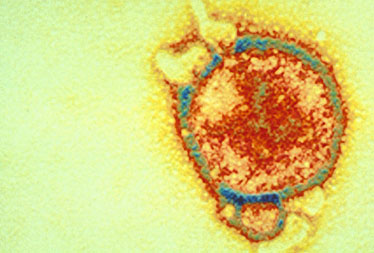美国国家卫生研究院等机构研究人员19日公布的报告显示,一种名为m102.4的人类单克隆抗体可以有效治疗感染亨德拉病毒的猴子,这为战胜这种致命病毒提供了新希望。

亨德拉病毒
亨德拉病毒是一种罕见病毒,因较强传染性而引起世人关注。美国国家卫生研究院等机构研究人员首先在蒙大拿州一个保护严密的实验室为14只非洲绿猴注射了致命剂量的亨德拉病毒,其中12只绿猴随后两次注射m102.4。实验结果显示,接受治疗的绿猴全部存活,另两只未接受治疗的绿猴在感染病毒8天后死去。
据研究人员介绍,他们2010年5月完成这项实验,之后澳大利亚卫生官员曾请求他们提供m102.4用于一名女性及其12岁女儿的紧急治疗。这两人曾因接触一只最终被安乐死的病马而感染亨德拉病毒。最终,接受m102.4治疗后,这两人均痊愈,并且没有不良反应。
这项研究成果19日发表在美国《科学·转化医学》杂志网络版上。
亨德拉病毒是美国国家卫生研究院生物防御研究项目研究的罕见病毒,它能攻击患者的肺部和大脑,死亡率高达60%。
亨德拉病毒最初名为马麻疹病毒,在1994年澳大利亚21匹马暴发急性呼吸道疾病期间第一次得到确认。世界卫生组织认为,虽然亨德拉病毒只导致少数疫情且迄今没有关于其人际传播的记录,但这种病毒可能进一步传播并有能力在人群中导致疾病和死亡,最终成为公共卫生问题。
在最近的疫情中,亨德拉病毒变得更加令人关注,因为马身上的症状已转变为以神经系统而不是呼吸系统疾病为主,这表明这种病毒可能具有遗传多样性,因此可能是一种传染性比以前认为更强的病毒。
相关英文论文摘要:
A Neutralizing Human Monoclonal Antibody Protects African Green Monkeys from Hendra Virus Challenge
Hendra virus (HeV) is a recently emerged zoonotic paramyxovirus that can cause a severe and often fatal disease in horses and humans. HeV is categorized as a biosafety level 4 agent, which has made the development of animal models and testing of potential therapeutics and vaccines challenging. Infection of African green monkeys (AGMs) with HeV was recently demonstrated, and disease mirrored fatal HeV infection in humans, manifesting as a multisystemic vasculitis with widespread virus replication in vascular tissues and severe pathologic manifestations in the lung, spleen, and brain. Here, we demonstrate that m102.4, a potent HeV-neutralizing human monoclonal antibody (hmAb), can protect AGMs from disease after infection with HeV. Fourteen AGMs were challenged intratracheally with a lethal dose of HeV, and 12 subjects were infused twice with a 100-mg dose of m102.4 beginning at either 10, 24, or 72 hours after infection and again about 48 hours later. The presence of viral RNA, infectious virus, and HeV-specific immune responses demonstrated that all subjects were infected after challenge. All 12 AGMs that received m102.4 survived infection, whereas the untreated control subjects succumbed to disease on day 8 after infection. Animals in the 72-hour treatment group exhibited neurological signs of disease, but all animals started to recover by day 16 after infection. These results represent successful post-exposure in vivo efficacy by an investigational drug against HeV and highlight the potential impact a hmAb can have on human disease.
英文论文链接:https://stm.sciencemag.org/content/3/105/105ra103.full?sid=a69ec7ab-1ee4-4751-a7f7-7f6f66a94b64







